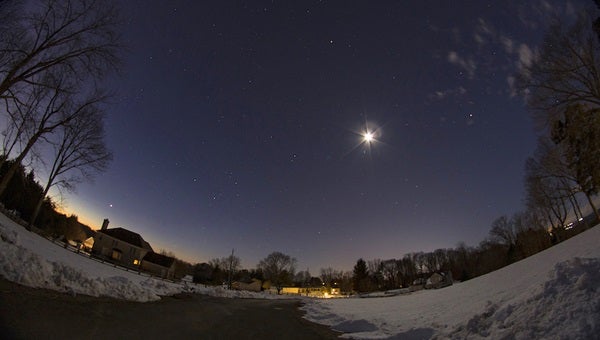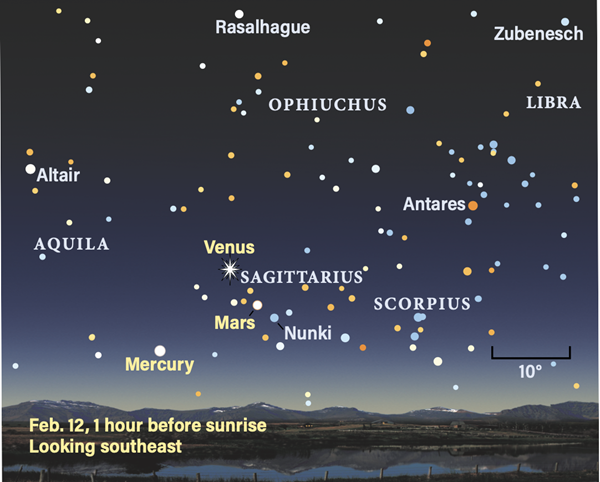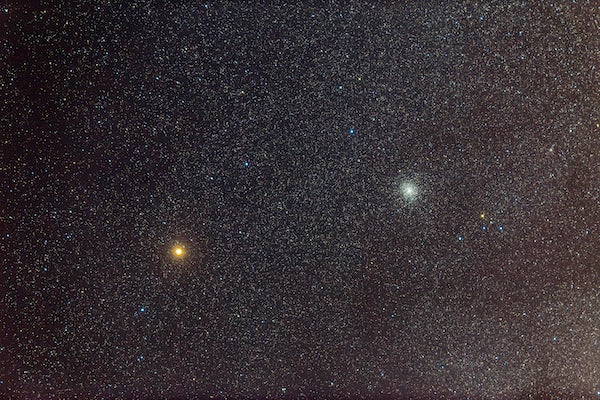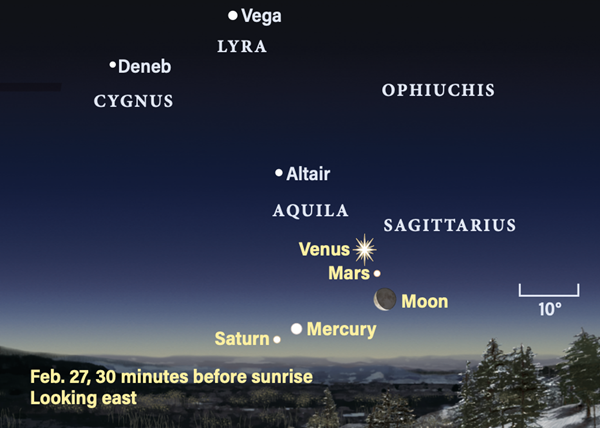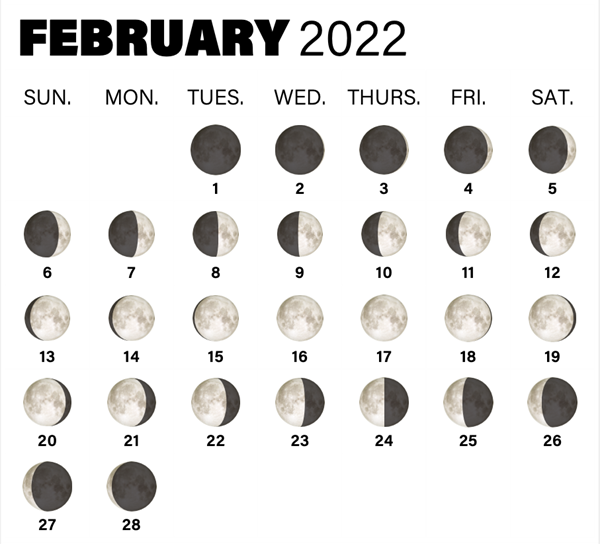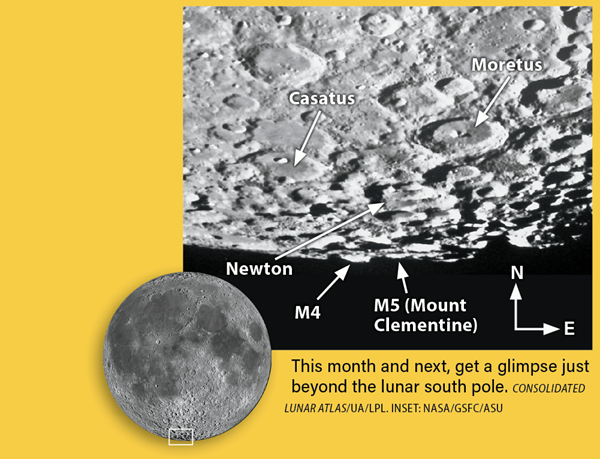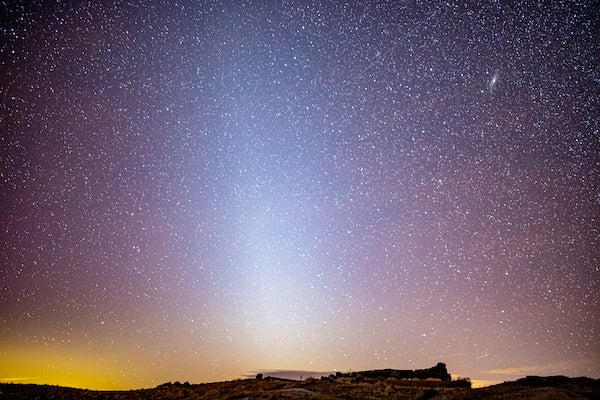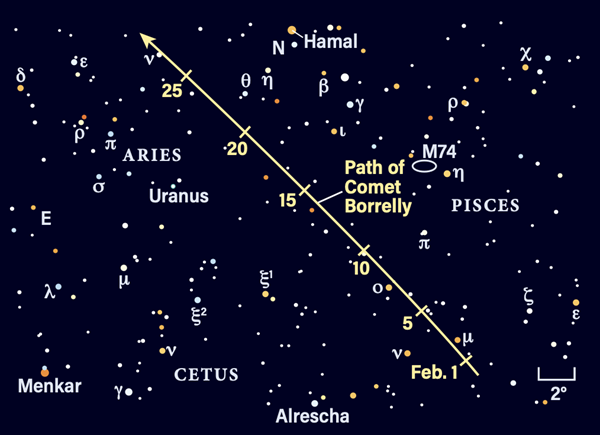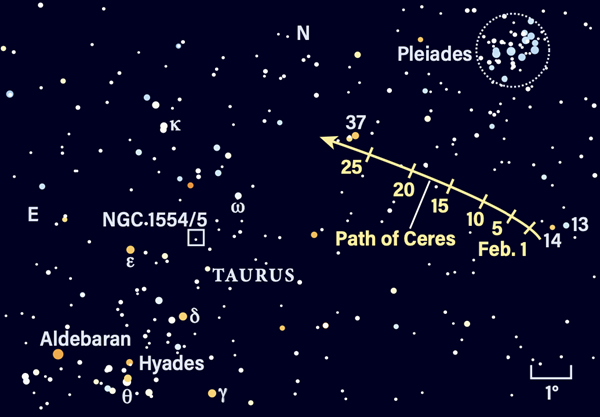Venus achieves its greatest brilliancy, dominating the predawn sky all month with its spectacular glow. Mars and Mercury join the dawn chorus of planets, and late in the month Saturn reappears from behind the Sun. With Jupiter heading for conjunction with our star, there are five major planets spanning less than 50° along the ecliptic by the end of February.
Let’s start with Jupiter, briefly visible after sunset during these early winter evenings. On Feb. 1, you’ll find the bright planet hanging 10° high in the western sky an hour after sunset. At magnitude –2, it’s bright enough to remain easily visible through the first week of February, and becomes more difficult to spot as the second week progresses.
Saturn’s conjunction with the Sun occurs Feb. 4. By the end of the month, it reappears near Mercury. Keep reading for more details on how to spot it in the morning sky.
Neptune sets three hours after sunset in early February. To spot this distant planet, try as soon as the sky is dark. On Feb. 3, the slender crescent Moon is a useful guide, with Neptune standing 4° due north of our satellite. The planet glows at magnitude 7.9 among the stars of eastern Aquarius the Water-bearer. A telescope will reveal a 6th-magnitude star 4° northeast of Phi (ϕ) Aquarii; Neptune lies only 1.5′ due north of this star on Feb. 3. The ice giant tracks to the northeast during the rest of the month and is consumed by twilight before month’s end.
Uranus is up all evening during February, located in Aries the Ram. It sets just after local midnight early in the month and about two hours earlier by the end of February. At magnitude 5.8, it’s just bright enough to spot with the unaided eye. But in a sparse region devoid of bright stars, it’s hard to track down.
The planet lies about 11° south-southeast of Hamal, the brightest star in Aries, and 5.3° north-northwest of Mu (μ) Ceti. On Feb. 1, it pairs up with 6th-magnitude 29 Arietis — the two are just 25′ apart. In binoculars, they should stand out as a close double, with slightly bluish Uranus due south of the star. A waxing Moon lies in the vicinity on Feb. 7. Uranus continues its easterly trek, moving to a point 43′ east of 29 Arietis by Feb. 28. Point your telescope at Uranus to spy its 3″-wide disk. This distant giant lies 1.9 billion miles from Earth.
All other planetary action occurs in the predawn sky, with four major planets visible in the latter half of February.
Venus reaches an unusually brilliant moment this month, when it outshines its normal greatest brilliancy by a few percent and hits magnitude –4.9 during the first half of February. Venus always reaches its brightest when it’s 26 percent lit, which occurs Feb. 12.
Typically, Venus is magnitude –4.5 at this time, but its actual brightness also depends on its distance from Earth. The reason Venus is exceptionally bright this month is that its elliptical orbit carries it closer to Earth than usual. The typical variation in distance is between 0.44 and 0.47 astronomical unit (AU; where 1 AU is the average Earth-Sun separation) — that’s 40.9 million to 43.7 million miles. This year, it’s just 0.41 AU (38 million miles), thus providing one of the rare moments that the planet exceeds its usual brilliance.
Follow Venus with a telescope throughout the month. Situated among the rich star fields of Sagittarius, you can’t miss it rising more than two hours before sunup. The best times to catch a glimpse are in late twilight or even daylight. That’s because the planet’s great brilliancy causes glare in your scope when the sky is dark, making it hard to see well.
On Feb. 1, Venus spans a giant 49″ on the sky but is a narrow, 16-percent-lit crescent. During the month, Venus fattens and shrinks in apparent size. By Feb. 13, it spans 40″ once it’s 26 percent lit and shining at its greatest brilliancy. Its brightness dips to –4.8 by Feb. 17, and by another 0.1 magnitude by the end of the month. Now the disk spans 32″ and is 38 percent lit. The bright planet’s good show will continue into March, when it reaches greatest elongation.
Mars joins Venus in the sky, although as a much fainter, dull orange ember glowing at magnitude 1.4. The Red Planet starts February 9° southwest of Venus and the pair moves across Sagittarius together in lockstep. Though a telescope, Mars is tiny, spanning 4″. It is beginning its slow progress to an end-of-year opposition.
By Feb. 12, Mars lies 6.6° south of Venus, the two planets straddling the Teaspoon asterism in eastern Sagittarius. They remain roughly this distance apart as they continue to trek with each other across the Archer’s starry realm.
You can spy Mercury an hour before sunrise, when it stands 19° east of Mars on Feb. 1, shining at magnitude 1.1. It brightens to magnitude 0.5 by Feb. 5. That same morning, check out Mars in binoculars: You’ll spot a bright globular cluster nearby. It’s M22, a 5th-magnitude cluster within easy reach of binoculars.
On Feb. 15, Mercury reaches magnitude 0 and is 14.5° east of Mars. The next day, Mercury reaches greatest western elongation, standing 26° from the Sun. Compare the angular separation of this innermost planet with the next planet out, Venus, which reaches its greatest elongation next month.
A waning crescent Moon joins the spectacular scene on Feb. 27. It stands 4.5° southeast of Mars as dawn breaks. Mercury has brightened a fraction to magnitude –0.1 and is located 18° east of the Moon. Look for the planet very low in the southeast in the brightening sky. Binoculars will find it easily. They’ll also help you locate Saturn 4° farther east of Mercury and shining at magnitude 0.7. They stand 2.5° and 4° high in the east, respectively, about 30 minutes before sunrise.
Mercury is at aphelion Feb. 28, just 12 days after greatest elongation. That morning, it stands 6.5° to the upper left of a 27-day-old, very thin waning crescent Moon. Saturn is 2.8° east of Mercury and harder to spot in bright twilight. It’s worth seeking out a good location with a clear eastern horizon these early mornings to catch four major planets and the Moon together at dawn.
Although Jupiter is close to conjunction with the Sun and isn’t visible late in the month, it’s worth pointing out that at the end of February, Mercury, Venus, Mars, Jupiter and Saturn span 49° along the ecliptic. If we include Neptune, also approaching conjunction, the six major planets span 57°. And this separation is closing: Next month they’ll be even closer.
Rising Moon: The mountain above the pole
Where’s the best place on the Moon for a solar power station? That would be a massive hill on the lunar farside, just beyond the south pole, which suffers only a brief interruption in continuous sunlight. M5, unofficially known as Mount Clementine, undergoes a short eclipse as the shifting shadow of its neighbor M4 swings across it once a month. By contrast, most places on the Moon must endure the day-night cycle that sports 14 Earth nights of darkness.
Without a doubt, Mount Clementine is the easiest farside feature to see — when the time is right. As the Moon hits a high above the Earth-Sun plane (the ecliptic), depicted as a red line on our Star Dome (see page 34), we have the opportunity to peer a bit beneath its south pole. Start on the 14th and return nightly through Full Moon on the 16th, when we get a near-perfect, outstanding 3D perspective. It’s as if you were in a helicopter flying low over waves rushing toward a beach. Our extra viewing angle shows us the shadow cast by every hill, reminiscent of the way dark eyeliner highlights the white of the eye.
Instead of shadows lying west of a rising Sun, here they are cast southward, gradually swinging around in an arc. The modestly tall bump in front of Mount Clementine at first casts its shadow to all the way to the base of M4; on following nights it marches eastward, crossing the base of Clementine. A few nights later, M4 itself puts Clementine in darkness, as in the image here. Use Casatus, Moretus, and Newton to nail the identification.
Be patient and wait for good seeing. The views will be quite rewarding. You may also pick out the crater rims of Shackleton and Faustini on the farside! At lower power, the glare from the Full Moon can be rather unbearable in larger instruments, so use a dark blue or green filter. But as you step up the power, you might not need one. Go back for another round next month near Full Moon, since the geometry almost repeats.
Meteor Watch: Gone, but not forgotten
There are no major meteor showers this month, but it’s still worth venturing out into the country in search of dark skies. While sporadic meteors can be seen at any time, February is also a good time to spot the zodiacal light.
Our solar system is filled with the dusty remains of long-dead comets. Sunlight reflecting off these billions of meteoritic particles causes the zodiacal light. It is detectable by eye soon after sunset under the right conditions. Select an observing location where the western sky is very dark, with few towns sporting street lighting. As the sky darkens, an hour or so after sunset, a cone-shaped glow similar to the Milky Way will become visible. It will appear steeply angled from the western horizon and aligned with the ecliptic, extending upward through Taurus the Bull. Observers located at higher altitudes are at an advantage, as they avoid the deeper dust-laden atmosphere of Earth.
Comet Search: In the alley of Aries
Alphonse Borrelly’s discovery in 1904 came 200 years after Edmond Halley’s famous prediction that some comets return. Yet Borrelly’s comet was only the 19th to be designated periodic. With a cycle of 6.86 years, Comet 19P/Borrelly will be back again in December 2028 with one of its best apparitions ever.
When it comes to brightness, distance is everything. In 2028, Borrelly will come within 0.41 AU. But our current apparition’s 1.3-AU distance cuts its shine to 9th to 10th magnitude. Our advantage this time is Borrelly’s altitude: It’s halfway up the southwestern sky as darkness sets in. Take a look in Pisces during the first few nights of February before the Moon interferes, then jump back at it in Aries as the dark-sky window reopens on the 18th.
Away from the city with an 8-inch scope at 150x, we will see a dense core with a sharply defined northern edge and a nicely broad V-shaped fan to the south. The trailing edge, where the bigger dust particles fall behind, will be diffuse. It will take truly dark skies and patience to pick it up in a 4-incher, while imagers should readily capture some classic green glow. The 5-mile-long, bowling-pin-shaped nucleus remains invisible behind the cloak of dust called the coma.
Locating Asteroids: Happy hunting
Rounding out at 600 miles across, 1 Ceres may be a dwarf planet, but it nevertheless rules the asteroid belt. Glowing at magnitude 8.5, its bright appearance makes it a good target to follow from the city with a 3-inch scope. Find it halfway between the Pleiades (M45) and the ruddy luminary Aldebaran high in the south.
The interstellar dust that gives the Pleiades their beautiful wispy clouds also helps us by blocking out the many potentially confusing Milky Way stars in the background. For the first half of February, Ceres is almost alone in a telescopic field, a few degrees northeast of the wide and almost equally bright pair of stars 13 and 14 Tau. Pause from the 7th to the 10th, while the Moon moves through.
The period from Feb. 25 to 28 is ideal for recording Ceres’ nightly motion. Use 37 Tau as a bright magnitude 4.3 anchor on the north side of your sketch. The main-belt asteroid will appear centered in a low-power field on the 27th. An earlier chance comes on the 21st — if you can tell the difference between a hockey stick shape and the perfect corner angle of a capital L. Two hours is all you need to see Ceres’ northeasterly displacement.

